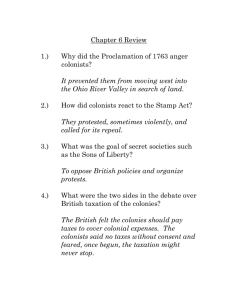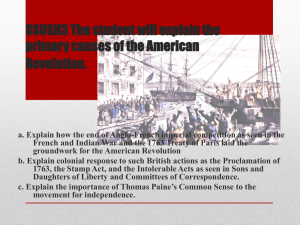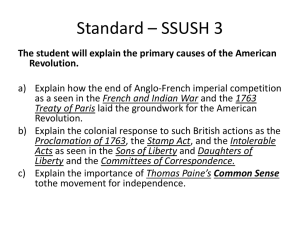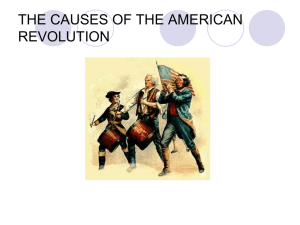Causes of the Revolution
advertisement
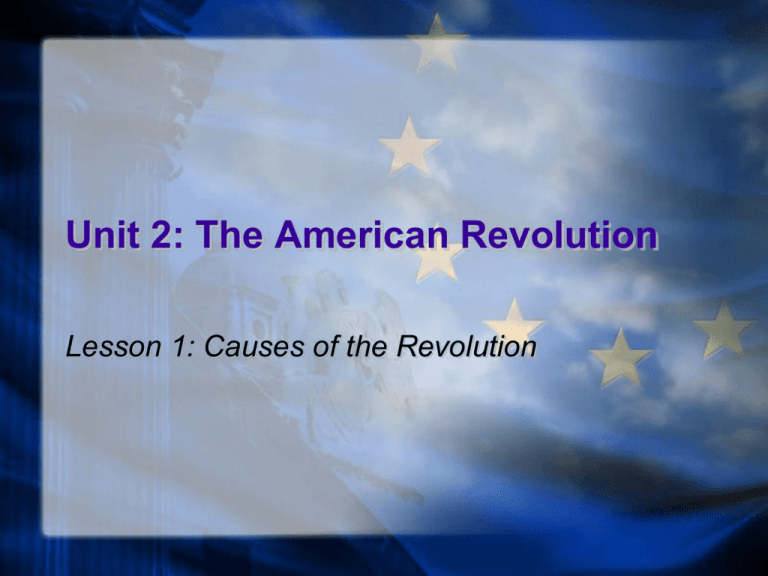
Unit 2: The American Revolution Lesson 1: Causes of the Revolution In 1754, Benjamin Franklin and representatives from the British colonies met in Albany, New York with chiefs from the Iroquois Confederation to discuss a joint defense against the French and loyal Indian tribes that allied with France. During these negotiations, Franklin developed a plan that would unite all the colonies under one government to help defend the British Empire. Although this concept, the Albany Plan of Union, was never passed by the Colonies, it illustrates the first attempt to strengthen ties between the colonies by unifying as one unit. To promote public support for this initiative, Franklin created this sketch of eight separate snake pieces and printed it in the Pennsylvania Gazette. The drawing was based on the popular superstition that a snake that had been cut in two would come to life if the pieces were joined before sunset. This drawing was widely circulated during the war and was the first political cartoon in American History. Opener 1. 2. The “Join or Die” cartoon is considered one of America’s first political cartoons. What is the message of the cartoon? Why do you think some colonists would resist the ideas in the message of this cartoon? The French and Indian War A European war that spread to America in 1754: British and French began fighting over the Ohio River Valley (transportation, farming, and fur) The colonists fought with Great Britain How does the idea of “Join or Die” relate? The French and Indian War The British defeated the French in the early 1760s (officially in 1763) France lost land east of the Miss. River While Great Britain won land, they were also in debt from the war To pay for the war the British began taxing the American colonies (Stamp Act) (How do you think many of the colonist felt about the British making them pay for the war?) French and Indian War - The British issued the Proclamation of 1763 which prohibited colonists from crossing the Appalachian Mountains in an attempt to keep peace with western Indian tribes. The British did not want to have to put the resources into protecting western colonial farmers. (Why would this policy upset some colonists?) Colonial Response to the British actions Stamp Act (1765): a British tax on most printed material- was the first direct tax on the colonies. Sons of Liberty(1765) organized protest meetings and intimidated tax collectors -led to the formation of the Stamp Act Congress which sent a petition to King George The British repeal the Stamp Act in 1766 More responses Townshend Acts (1767): tax on certain imported goods (indirect tax) Most early resistance to the British Actions was found in Boston British Actions Intolerable Acts (1774): Laws intended to punish Massachusetts, where the majority of the boycotts against the British were taking place 1. -Shut down the port of Boston 2. -Limited colonial voting rights 3. -Limited the power of colonial courts 4. -Forced the colony to house British soldiers The Colonists Respond Committees of Correspondences were formed to help communication between colonies: helped unify the colonies against the British -The Daughters of Liberty and the Sons of Liberty both organized effective boycotts of British goods: Daughters of Liberty promoted wearing “homespun The first shots… The first conflict occurred BEFORE the Colonies officially declare their independence “The shot heard around the world” School House Rocks http://www.schooltube.com/video/66c69ce5b14 549058b63/Shot-Heard-Round-the-World Discussion Questions! 1. 2. 3. What were some of the major British actions that angered the American colonists? What protest groups formed in response to these British actions? When did these protest groups form (after what event)?



